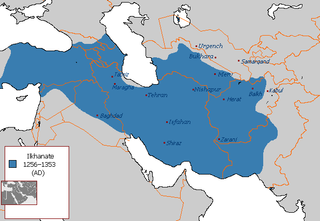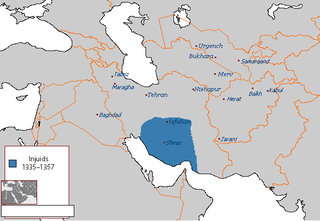
The Ilkhanate, also spelled Il-khanate, was established as a khanate that formed the southwestern sector of the Mongol Empire, ruled by the Mongol House of Hulagu. It was founded in the 13th century and was based primarily in Iran as well as neighboring territories, such as present-day Azerbaijan and the central and eastern parts of present-day Turkey. The Ilkhanate was originally based on the campaigns of Genghis Khan in the Khwarazmian Empire in 1219–24 and was founded by Hulagu Khan, son of Tolui and grandson of Genghis Khan. With the fragmentation of the Mongol Empire after 1259 it became a functionally separate khanate. At its greatest extent, the state expanded into territories that today comprise most of Iran, Iraq, Armenia, Azerbaijan, Georgia, Turkmenistan, Turkey, western Afghanistan, and the Northwestern edge of the Indian sub-continent. Later Ilkhanate rulers, beginning with Ghazan in 1295, converted to Islam.
Hasan Kuchak or Ḥasan-i Kūchik was a Chupanid prince during the 14th century. He is credited with setting up a nearly independent Chupanid state in northern Persia during the struggles taking place in the aftermath of the Ilkhanate.

The House of Inju was a Shia dynasty of Mongol origin that came to rule over the Persian cities of Shiraz and Isfahan during the 14th century AD. Its members became de facto independent rulers following the breakup of the Ilkhanate until their defeat in 1357.
Shaikh Hasan, called "Buzurg", was the first of several de facto independent Jalayirid rulers of Iraq and central Iran. He was the son of Husain and Öljetey. His sister Soyurghatmish Khatun was married to Öljaitü Khan.

The Kurt dynasty, also known as the Kartids, was a Sunni Muslim dynasty of Tajik origin, that ruled over a large part of Khorasan during the 13th and 14th centuries. Ruling from their capital at Herat and central Khorasan in the Bamyan, they were at first subordinates of Sultan Abul-Fateh Ghiyāṣ-ud-din Muhammad bin Sām, Sultan of the Ghurid Empire, of whom they were related, and then as vassal princes within the Mongol Empire. Upon the fragmentation of the Ilkhanate in 1335, Mu'izz-uddin Husayn ibn Ghiyath-uddin worked to expand his principality. The death of Husayn b. Ghiyath-uddin in 1370 and the invasion of Timur in 1381, ended the Kurt dynasty's ambitions.

Togha Temür, also known as Taghaytimur, was a claimant to the throne of the Ilkhanate in the mid-14th century. Of the many individuals who attempted to become Ilkhan after the death of Abu Sa'id, Togha Temür was the only one who hailed from eastern Iran, and was the last major candidate who was of the house of Genghis Khan. His base of power was Gurgan and western Khurasan. His name "Togoy Tomor" means "Bowl/Pot Iron" in the Mongolian language.
Shams al-Din is an Arabic personal name or title.
Amir Vali was the ruler of Astarabad and parts of Mazandaran from 1356 until 1366, and again from c. 1374 until 1384. His relatively long reign was dominated by conflict with the Sarbadars and the Jalayirids, and ended only upon the arrival of Timur into eastern Persia.
Kulū Isfandiyār was the leader of the Sarbadars of Sabzewar from 1346 until around 1347.
Shams al-Din was the leader of the Sarbadars of Sabzewar from 1347 until around 1348.
Yahya Karawi was the leader of the Sarbadars of Sabzewar from around 1353 until his death.
Zahir al-Din Karawi was the leader of the Sarbadars of Sabzewar from 1356 - 1359
Haidar Qassāb was the head of the Sarbadars of Sabzewar During 1356.
Lutf Allah was the leader of the Sarbadars of Sabzewar from 1356 until his death.
The Battle of Zava was fought on July 18, 1342 between the armies of the Sarbadars and the Kartids. Since their appearance as a political force in Khorasan, the Sarbadars had fought to expand their influence in north-eastern Iran and defend against the forces of the claiming Ilkhan Togha Temür who sought to regain Khorasan. Mu'izz al-Din Husain, the chief of the Kartids of Herat, recognized Togha Temur's overlordship, and when the Sarbadars secured their hold on Khorasan they sought to eliminate the Kartid threat to the east.
Hasan II, also known as Fakhr al-Dawla Hasan, was the last ruler of the Bavand dynasty from 1334 to 1349. He was the brother, and successor of Sharaf al-Muluk.
Eskandar II, was the ruler of the Paduspanid dynasty from 1333 to 1359. He was the son and successor of Taj al-Dawla Ziyar.









